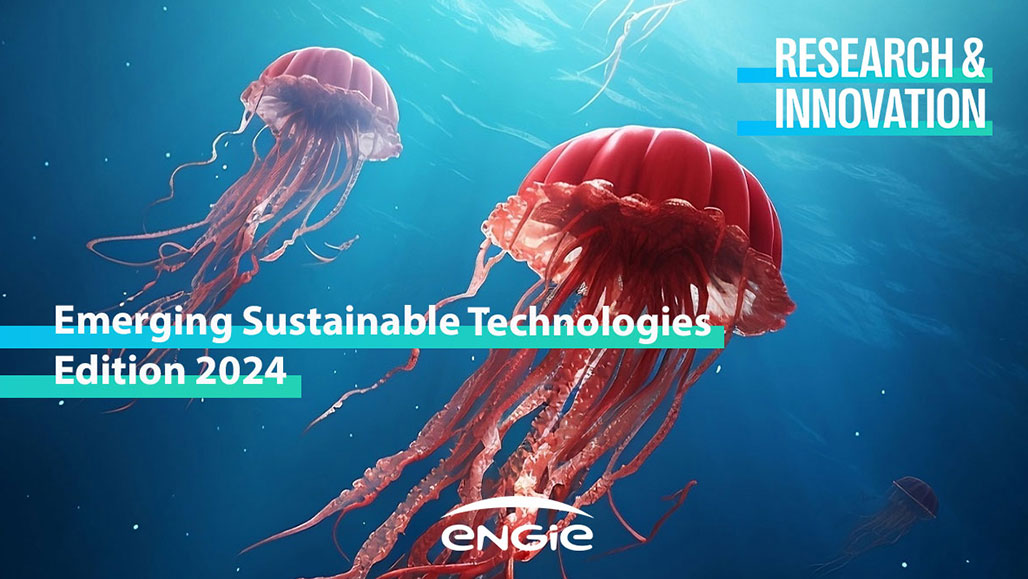

Oceans and seas cover 70% of the surface of the globe. Not only do they support intercontinental trade flows, but they are home to incredibly varied marine life and provide us with food, energy, recreation and holiday spots. Moreover, more than 60% of the global population lives within 150 km of the coast.
They also help regulate the world’s climate and act as a large long-term carbon sink. Of the nearly 40 gigatons of CO2 emitted from fossil fuel use every year, 13 gigatons are captured on land and around 9 gigatons by the oceans, leading to a yearly net increase of around 18 gigatons of fossil fuel-generated CO2 in the atmosphere. Whatever we come up with in our development of novel offshore technologies, we must never forget that the need to protect oceans’ vital functions has to be a top priority.
Discover the Digital Animation of the 2024 ReportThe insight that the ocean can contribute to the fight against the climate crisis led,
Key to succeed in the energy transition, is the idea that all these technologies will need to interact. Therefore, the report touches upon this to some extend by highlighting possible synergies that will co-exist between the different technologies. There is no single miracle or standalone solution. The future will be a system of interconnected systems and technologies.
There is no doubt in our minds that the journey ahead is too complex and too resource intensive for a single company, a single industry, a single country, or even a single continent to deliver the kind of effective solutions the world needs. What is equally obvious is that oceans will play a critical role in achieving our climate goals and moreover, not achieving our climate goals will deteriorate the crucial function(s) our oceans play.
Discover the Digital Animation of the 2024 ReportOceans could become part of solving the critical raw mineral challenge generated by the massive requirements of our clean energy technologies such as photovoltaics, wind turbines and batteries.
In this first part, we present emerging offshore technologies for energy production and energy storage. Offshore fixed-bottom or floating wind energy can now be considered a mature, scalable technology and is therefore not covered in this document.
Meanwhile, wave and tidal energy, osmotic power, floating solar, large-scale offshore energy storage and other approaches are still in their early phase of development, mainly due to high costs and technical challenges related to harsh conditions at sea compared to land-based solutions.
Discover
Osmotic power plants can be built where freshwater rivers meet the sea, to take advantage of the natural osmotic gradient. The energy thus generated can be considered a completely renewable and sustainable,CO2 low source of energy.
Marine floating PVs consist of floating structures supporting PV installations which use solar radiation to produce electricity. Accessing additional space with less usage competition, floating PVs enable more renewable energy production, either alone or in synergy with other marine technologies.
DiscoverMarine floating PVs consist of floating structures supporting PV installations which use solar radiation to produce electricity. Accessing additional space with less usage competition, floating PVs enable more renewable energy production, either alone or in synergy with other marine technologies.
DiscoverHere we focus on the ocean as a resource: e.g., for drinking water and minerals. Ocean and sea water contains many elements of Mendeleev’s Table. This means the oceans could become part of solving the critical raw mineral challenge generated by the massive requirements of our clean energy technologies. Research is needed to determine whether we can extract these minerals in an efficient manner, and to gauge the impact this would have on oceanic biodiversity & environment.

Ocean and sea water contains many elements of Mendeleev’s Table. This means the oceans could become part of solving the critical raw mineral challenge generated by the massive requirements of our clean energy technologies such as photovoltaics, wind turbines and batteries.
DiscoverOcean and sea water contains many elements of Mendeleev’s Table. This means the oceans could become part of solving the critical raw mineral challenge generated by the massive requirements of our clean energy technologies such as photovoltaics, wind turbines and batteries.
DiscoverAlong with land-based solutions, mobilizing the ocean with CO2 removal technologies will be needed for climate mitigation.
A panorama of the seven main ocean-based negative emission technologies is presented and then there is a focus on direct ocean capture technologies in this third part.
Discover
Ocean and sea water contains many elements of Mendeleev’s Table. This means the oceans could become part of solving the critical raw mineral challenge generated by the massive requirements of our clean energy technologies such as photovoltaics, wind turbines and batteries.
DiscoverEnvironmental-DNA is an example of a novel and efficient way to monitor offshore biodiversity which is crucial to all solutions presented. It is a non-invasive, indirect species detection technique based on the analysis of DNA sequences collected from a given environment.
KEY AUTHORS: Elodie du Fornel, Elodie Le Cadre Loret, Jan Mertens, Jean-Pierre Keustermans, Céline Denis, Olivier Sala.
CO-AUTHORS: Fiona Buckley, Julie Clavreul, Camille Rivière,Stephane Fortin, Pierre Olivier, Anass Berrardy, Lionel Nadeau, Aurore Castet, Gregor Strugala,Quentin Van Nieuwenhoven, Andreas Wabbes, Marie-Laure Thielens, Daniel Baaklini, Benjamin Metayer, Jean Sanchez, Raphaël Briere, Steve Nardone, Anne Prieur Vernat, Julien Merlin, BartGhysels, Ahmed Mkaouar, Ngoc Han Huynh Thi, Jonas Pigeon, Sarah Pahlol, Coline Bouzique, Caroline De Zutter, Luca Barbetti, Ali Dastgheib, Cleo Pandelaers & Boudewijn Decrop and Arash Bakhtiari.